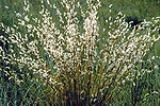
Little bluestem
Encyclopedia
Schizachyrium scoparium, commonly known as little bluestem or beard grass, is a North America
n prairie
grass
. Little bluestem is a perennial
bunchgrass
and is prominent in tallgrass prairie
, along with big bluestem (Andropogon gerardii), indiangrass (Sorghastrum nutans
) and switchgrass (Panicum virgatum). It is a warm-season
species, meaning it employs the C4 photosynthetic pathway.
Little bluestem grows to a typical height of 3 feet. Although it has a blue tint in the spring, in fall, its predominant color is more red, which color it may retain throughout winter into spring. The plant prefers well-drained sunny sites.
North America
North America is a continent wholly within the Northern Hemisphere and almost wholly within the Western Hemisphere. It is also considered a northern subcontinent of the Americas...
n prairie
Prairie
Prairies are considered part of the temperate grasslands, savannas, and shrublands biome by ecologists, based on similar temperate climates, moderate rainfall, and grasses, herbs, and shrubs, rather than trees, as the dominant vegetation type...
grass
Grass
Grasses, or more technically graminoids, are monocotyledonous, usually herbaceous plants with narrow leaves growing from the base. They include the "true grasses", of the Poaceae family, as well as the sedges and the rushes . The true grasses include cereals, bamboo and the grasses of lawns ...
. Little bluestem is a perennial
Perennial plant
A perennial plant or simply perennial is a plant that lives for more than two years. The term is often used to differentiate a plant from shorter lived annuals and biennials. The term is sometimes misused by commercial gardeners or horticulturalists to describe only herbaceous perennials...
bunchgrass
Tussock (grass)
Tussock grasses or bunch grasses are found as native plants in natural ecosystems, as forage in pastures, and as ornamental grasses in gardens....
and is prominent in tallgrass prairie
Tallgrass prairie
The tallgrass prairie is an ecosystem native to central North America, with fire as its primary periodic disturbance. In the past, tallgrass prairies covered a large portion of the American Midwest, just east of the Great Plains, and portions of the Canadian Prairies. They flourished in areas with...
, along with big bluestem (Andropogon gerardii), indiangrass (Sorghastrum nutans
Sorghastrum nutans
Sorghastrum nutans, commonly known as Yellow Indiangrass, is a North American prairie grass found in the central and eastern United States and Canada, especially in the Great Plains...
) and switchgrass (Panicum virgatum). It is a warm-season
C4 carbon fixation
C4 carbon fixation is one of three biochemical mechanisms, along with and CAM photosynthesis, used in carbon fixation. It is named for the 4-carbon molecule present in the first product of carbon fixation in these plants, in contrast to the 3-carbon molecule products in plants. fixation is an...
species, meaning it employs the C4 photosynthetic pathway.
Little bluestem grows to a typical height of 3 feet. Although it has a blue tint in the spring, in fall, its predominant color is more red, which color it may retain throughout winter into spring. The plant prefers well-drained sunny sites.

